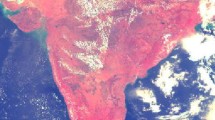Abstract
The accuracy of the satellite-measured reflectance is a key question for data processing and oceanographic applications. A hyperspectral satellite remote sensing reflectance evaluation model (HRSREM) was developed to evaluate the accuracy of the satellite measured reflectance. The model can compute the total reflectance at the top of the atmosphere (TOA) according to observation conditions of satellites, based on a radiative transfer model with the consideration of multiple scattering effects and atmospheric absorption effects. The performance of the HRSREM model was examined by Gordon’s algorithms, showing that the relative errors of the Rayleigh scattering reflectance and the aerosol scattering reflectance are less than 2%. The model can also compute the sky reflectance which can be validated by in-situ measurements. The two sky reflectances match well with a spectral average error of 5.4%. The relative error of the total reflectance of the model, verified by sea-viewing wide field-of-view sensor (SeaWiFS) data, is about 3.5%. Therefore, the total reflectances at TOA, computed by the model, can be taken as reference values to evaluate the accuracy of satellite reflectances. The model was used to evaluate the accuracy of the hypersptral satellite (Hyperion) remote sensing data. The Hyperion reflectance matches the total reflectance of HRSREM very well at visible and near-infrared bands with an average error of 7.3%, while the status of calibration coefficients at shortwave infrared bands are not stable with a large spectral average error of 63.5%. The reflectance evaluation of a moderate resolution imaging spectrometer (CMODIS) data indicated that relative errors are large, especially at near-infrared bands with relative errors more than 100%. The calibration coefficients of CMODIS, obtained from laboratory measurements, are not reliable. The CMODIS data should be recalibrated for oceanographic applications. The performance of the HRSREM model is effective in evaluating satellite data and its algorithms can be easily modified in order to evaluate the accuracy of other ocean color satellite sensors.
Similar content being viewed by others
References
Barnes R A, Eplee Jr. R E, Patt F S, et al. Changes in the radiometric sensitivity of SeaWiFS determined from Lunar and Solar-based measurements. Appl Opt, 1999, 21: 4649–4664
Wang M, Gordon H R. A simple, moderately accurate, atmospheric correction algorithm for SeaWiFS. Remote Sens Envir, 1994, 50: 231–239
Barnes R A, Barnes W L, Esaias W E, et al. Prelaunch acceptance report for the SeaWiFS radiometer. NASA Tech Memo, 1994, 22: 104566
Hooker S B, Lazin G, Zibordi G, et al. An evaluation of above-and in-water methods for determining water-leaving reflectances. J Atmos Ocea Tech, 2002, 19: 486–515
Gordon H R, Wang M. Retrieval of water-leaving reflectance and aerosol optical thickness over the oceans with SeaWiFS: A preliminary algorithm. Appl Opt, 1994, 33: 443–452
Mao Z, Huang H, Pan D. The atmospheric correction algorithm of SeaWiFS data in China Sea. Ocean Limno Sin, 2001, 32: 581–587
Pan D, He X, Zhu Q. In-orbit cross-calibration of HY-1A satellite sensor COCTS. Chinese Sci Bull, 2004, 49: 2521–2526
Wang M, Franz B A. Comparing the ocean color measurements between MOS and SeaWiFS: A vicarious intercalibration approach for MOS. IEEE Trans Geosci Remote Sens, 2000, 38: 184–197
Shanmugam P, Ahn Y H. New atmospheric correction technique to retrieve the ocean colour from SeaWiFS imagery in complex coastal waters. J Opt A, 2007, 9: 511–530
Toratani M, Fukushima H, Murakami H, et al. Atmospheric correction scheme for GLI with absorptive aerosol correction. J Ocean, 2007, 63: 525–532
Wang M. Validation study of the SeaWiFS oxygen A-band absorption correction: comparing the retrieved cloud optical thicknesses from SeaWiFS measurements. Appl Opt, 1999, 38: 937–944
Author information
Authors and Affiliations
Corresponding author
Rights and permissions
About this article
Cite this article
Mao, Z., Chen, J., Huang, H. et al. Establishment of a hyperspectral evaluation model of ocean color satellite-measured reflectance. Sci. China Inf. Sci. 53, 1891–1902 (2010). https://doi.org/10.1007/s11432-010-4048-z
Received:
Accepted:
Published:
Issue Date:
DOI: https://doi.org/10.1007/s11432-010-4048-z




